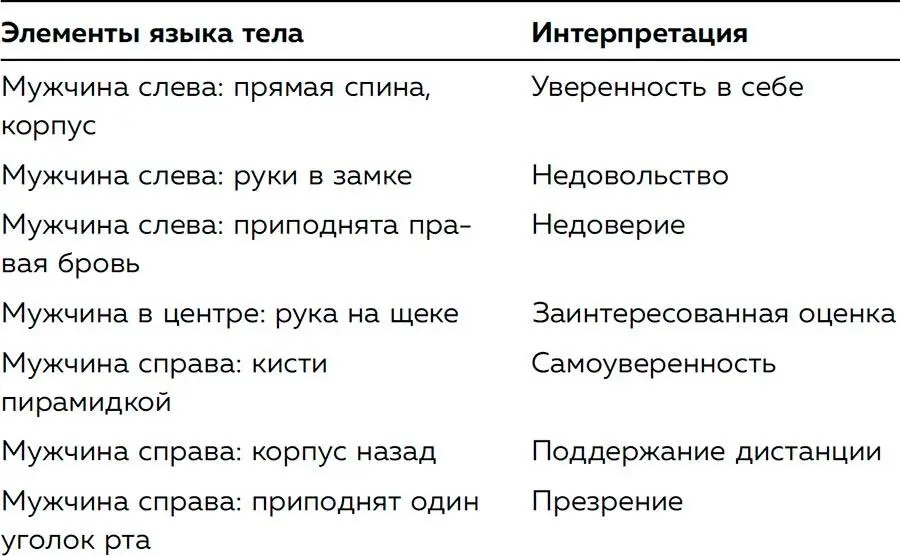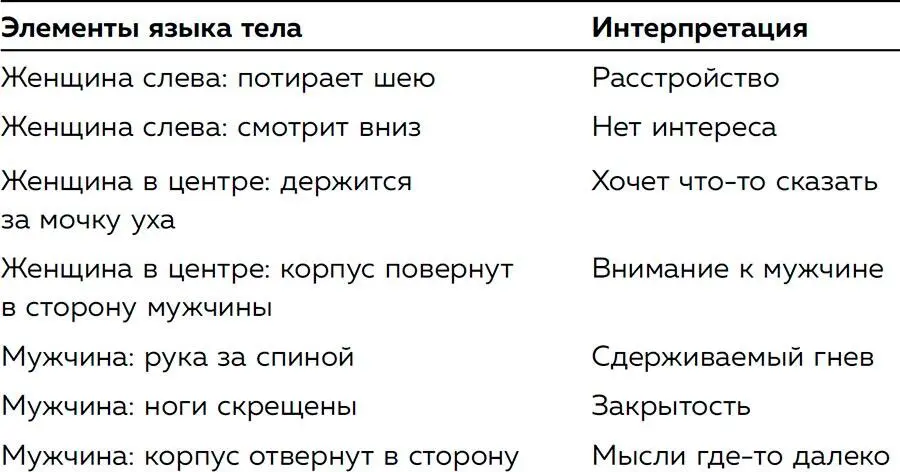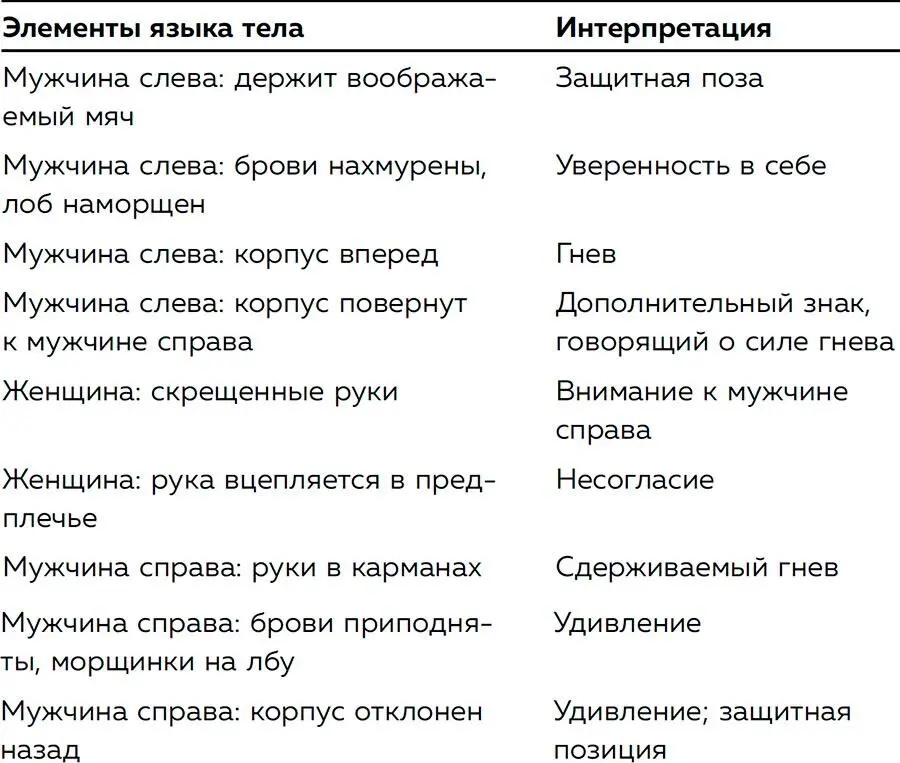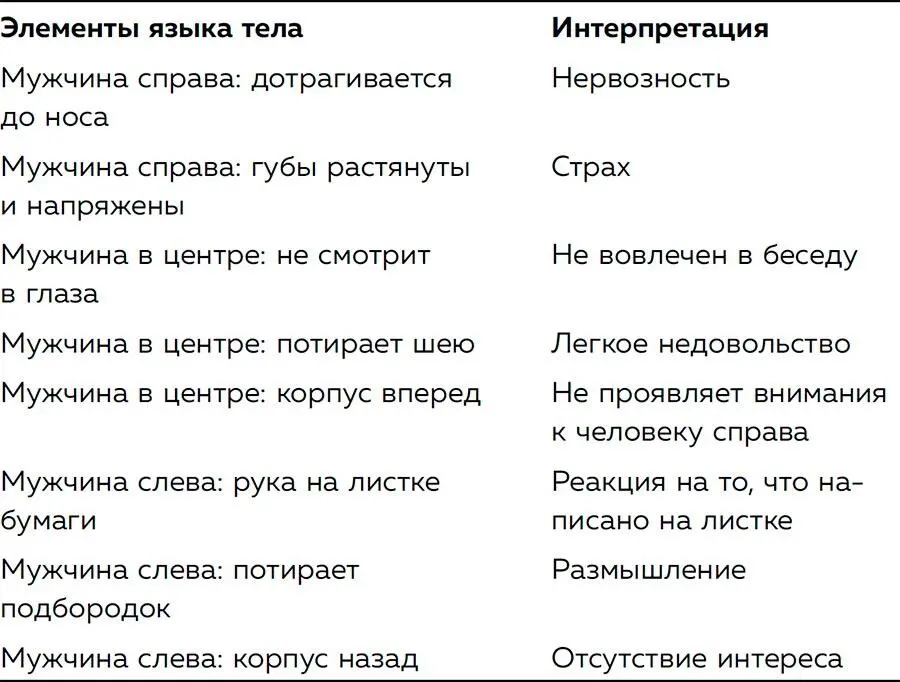Касия Везовски - Я понимаю тебя без слов [Как читать людей по жестам и мимике] [litres]
- Название:Я понимаю тебя без слов [Как читать людей по жестам и мимике] [litres]
- Автор:
- Жанр:
- Издательство:Литагент 5 редакция «БОМБОРА»
- Год:2018
- ISBN:978-5-04-110476-4
- Рейтинг:
- Избранное:Добавить в избранное
-
Отзывы:
-
Ваша оценка:
Касия Везовски - Я понимаю тебя без слов [Как читать людей по жестам и мимике] [litres] краткое содержание
Я понимаю тебя без слов [Как читать людей по жестам и мимике] [litres] - читать онлайн бесплатно ознакомительный отрывок
Интервал:
Закладка:
Контекст:переговоры о продажах. Тот, кто справа, хочет продать товар (коробочка, которая лежит на столе). Двое мужчин слева думают, стоит ли его покупать. Перед мужчиной слева лежит коммерческое предложение. Как вы думаете, состоится ли сделка, и как продавец мог бы повысить шансы на успех?
Ситуация 1

Вывод
Мужчина справа очень уверен в себе – об этом говорит жест «пирамидка» и улыбочка превосходства. Мужчина слева явно недоволен, тогда как мужчина в центре настроен более позитивно. Если начальник тот, что слева, у кандидата нет шансов получить работу. Если же главнее тот, кто в центре, надежда есть, несмотря на самодовольство соискателя.
Ситуация 2

Вывод
Язык тела женщины слева и мужчины явно указывает на то, что разговор не клеится. В воздухе ощущается напряжение. Женщина в центре явно хочет что-то сказать мужчине. Возможно, это разрядит обстановку.
Ситуация 3

Вывод
Мужчина слева злится из-за какой-то ситуации. Скорее всего, причиной его гнева является мужчина справа. Женщина не полностью согласна со словами мужчины слева и противостоит его агрессии. Мужчина справа удивлен поведением мужчины слева.
Ситуация 4

Вывод
Продавец (справа) очень нервничает и поэтому звучит совершенно неубедительно. Мы не можем знать, врет он или нет, но в его презентации товара явно есть какие-то нестыковки. Потенциальные покупатели (слева) настроены не очень-то благосклонно. Тот, что слева, явно невысокого мнения о предлагаемом товаре. Если второй еще раздумывает, то этот уже принял решение, просто еще не озвучил его. А это значит, что, если последнее слово за мужчиной слева, то у продавца нет шансов. Если же главнее тот, кто в центре, тогда шансы есть, но они не велики.
«Невербальные сигналы – наши указатели на пути к успеху».
Библиография
Aboyoun, D. C., Dabbs, J. M. (1998). “The Hess Pupil Dilation Findings: Sex or Novelty?” Social Behavior & Personality 26 (4), 415–419.
Ambady, N., Skowronski, J. J. (2008). First Impressions. New York: Guilford Press.
Argyle, M. (1988). Bodily Communication. London: Methuen.
Bach, L. (1908). Pupillenlehre. Anatomie, Physiologie und Pathologie. Methodik der Untersuching. Berlin: Karger.
Barber, C. (1964). The Story of Language. London: Pan Books.
Barton, K., Fugelsang, J., and Smilek, D. (2009). “Inhibiting Beliefs Demands Attention.” Thinking and Reasoning 15 (3), 250–267.
Beebe, S. A. (1979). Nonverbal Communication in Business: Principles and Applications.
Bernstein M. J., Young, S. G., Brown, C. M., Sacco D. F., and Claypool, H. M. (1998). “Adaptive Responses to Social Exclusion: Social Rejection Improves Detection of Real and Fake Smiles.” Psychological Science 19 (10), 981–983.
Bernstein M. J., Sacco D. F., Brown, C. M., Young, S. G., and Claypool, H. M. (2010). “A Preference for Genuine Smiles Following Social Exclusion.” Journal of Experimental Social Psychology 46, 196–199.
Blahna, L. (1975). A Survey of Research on Sex Differences in Nonverbal Communication. Speech Communication Association.
Bov é e, C. L., Thill, J. V., and Schatzman, B. E. (2003). Business Communication Today (7th ed.). New Jersey: Prentice Hall
Buck, R. (1984). The Communication of Emotion. New York: Guilford Press.
Burgoon, J. K., Manusov, V., Mineo, P., Hale, J. L. (1985). “Effects of Gaze on Hiring, Credibility, Attraction and Relational Message Interpretation.” Journal of Nonverbal Behavior 9 (3), 133–146.
Calero, H. H. (2005). The Power of Nonverbal Communication. Los Angeles: Silver Lake.
Caputo, J. S., Hazel, H. C., McMahon, C., and Darnels, D. (2002). Communicating Effectively: Linking Thought and Expression. Dubuque, Iowa: Kandall-Hunt Publishing.
Carney, D., Cuddy, A. J. C., and Yap, A. (2010). “Power Posing: Brief Nonverbal Displays Affect Neuroendocrine Levels and Risk Tolerance.” Psychological Science 21 (10), 1363–1368.
Chaney, R. H., Linzmayer, L., Grunberger, M., and Saletu, B. (1989). “Pupillary Responses in Recognizing Awareness in Persons with Profound Mental Retardation.” Perceptual & Motor Skills 69, 523–528.
Cody, M., and O’Hair, D. (1983). “Nonverbal Communication and Deception: Differences in Deception Cues Due to Gender and Communication Dominance.” Communication Monographs 50, 175–192.
Coker, D. A., and Burgoon, J. K. (1987). “The Nature of Conversational Involvement and Nonverbal Encoding Patterns.” Human Communication Research 13, 463–494.
Collier, G. (1985). Emotional Expression. Hillsdale: Lawrence Erlbaum Associates.
Cuddy, A. J. C., Glick, P., and Beninger, A. (2011). “The Dynamics of Warmth and Competence Judgments, and Their Outcomes in Organizations.” Research in Organizational Behavior 31, 73–98.
Darwin, C. (1872/1965). The Expression of the Emotions in Man and Animals. Chicago: University of Chicago Press.
Davidson, R. J., Scherer, K. R., and Goldsmith, H. H. (2009). Handbook of Affective Sciences. New York: Oxford University Press.
Davitz, J. R. (1964). The Communication of Emotional Meaning. New York: McGraw-Hill.
DePaulo, B.M., Friedman H. S. (1998). “Nonverbal Communication.” In D. Gilbert, S. T. Fiske, and G. Lindzey, eds., Handbook of Social Psychology (4th ed.). New York: Random House, 3—40.
Devito, A. J. (2009). Human Communication. Boston: Pearson Education.
Di Leo, J. H. (1977). Child Development: Analysis and Synthesis. New York: Brunner/Mazel.
Duchenne de Boulogne, C. B. (1862/1990). The Mechanism of Human Facial Expression. Cambridge: Cambridge University Press.
Eastwood, J. D., and Smilek, D. (2005). “Functional Consequences of Perceiving Facial Expressions of Emotion Without Awareness.” Consciousness and Cognition 14 (3), 565–584.
Eastwood, J. D., Smilek, D., and Merikle, P.M. (2003). “Negative Facial Expression Captures Attention and Disrupts Performance.” Perception & Psychophysics 65 (3), 352–358.
Ekman, P., Friesen, W. V., and Ellsworth, P. (1972). Emotions in the Human Face: Guidelines for Research and an Integration of Findings. New York: Pergamon Press.
Ekman, P. E., Rosenberg, E. L. (1997). What the Face Reveals; Basic and Applied Studies of Spontaneous Expression Using the Facial Action Coding System. New York: Oxford University Press.
Exline, R. V., Ellyson, S. L., and Long, B. (1975). “Visual Behavior as an Aspect of Power Role Relationships.” In Pliner, Krames, and Alloway (eds.) Advance. New York: Plenum, 21–52.
Fast, J. (1991). Body Language in the Work Place. New York: Penguin Books.
Feldman, R. S., Rimei, B. (1991). Fundamentals of Nonverbal Behavior. Cambridge: Cambridge University Press.
Forbes, R. J., Jackson, P. R. (1980). “Non-verbal Behavior and the Outcome of Selection Interviews.” Journal of Occupational Psychology 53, 65–72.
Fretz, B. R., Corn, R., Tuemmler, J. M., and Bellet, W. (1979). “Counselor Nonverbal Behaviors and Client Evaluations.” Journal of Counselling Psychology 26, 304–343.
Friedman, D., Hakerem, G., Sutton, S., and Fleiss, J. L. (1973). “Effect of Stimulus Uncertainty on the Pupillary Dilation Response and the Vertex Evoked Potential.” Electroencephalography and Clinical Neurophysiology 34, 475–484.
Friedman, H. S., Riggio, R. E. and Casella, D. F. (1988). “Nonverbal Skill, Personal Charisma, and Initial Attraction.” Personality and Social Psychology Bulletin 74 (14), 203–211.
Gilbert, D. T., Fiske, S. T. and Lindzey, G. The Handbook of Social Psychology (4th ed., vol. 2). New York: McGraw-Hill, 504–553.
Given, D. B. (2002). The Nonverbal Dictionary of Gestures, Signs and Body Language Cues. Washington: Center for Nonverbal Studies Press.
Goode, E. E., Schrof, J. M., and Burke, S. (1998). “Where Emotions Come From.” Psychology 97/98 (62), 54–60.
Goldberg, S., Rosenthal, R. (1986). “Self-touching Behavior in the Job Interview: Antecedents and Consequences.” Journal of Nonverbal Behavior 10 (1), 65–80.
Gunnery, S., Hall, J., and Ruben, M. (2012). “The Deliberate Duchenne Smile: Individual Differences in Expressive Control.” Journal of Nonverbal Behavior. DOI: 10.1007/s10919—012—0139—4.
Haggard, E. A. and Isaacs, K. S. (1966). “Micro-momentary Facial Expressions as Indicators of Ego Mechanisms in Psychotherapy.” In L. A. Gottschalk and A. H. Auerbach (eds.), Methods of Research in Psychotherapy. New York: Appleton-Century-Crofts, 154–165.
Hall, E. T. (1973). The Silent Language. New York: Anchor.
Hall, E. T. (1976). The Hidden Dimension. New York: Doubleday.
Harper, D. (2002). “Talking About Pictures: A Case for Photo Elicitation.” Visual Studies 17 (1), 13–26.
Hertenstein, M. J., Hansel, C. A., Butts A. M., and Hile S. N. (2009). “Smile Intensity in Photographs Predicts Divorce Later in Life.” Motivation and Emotion 33 (2), 99—105.
Hess, E. H. (1964). “Attitude and Pupil Size.” Scientific American 212, 46–54.
Hess, E. H. (1975). The Tell-tale Eye: How Your Eyes Reveal Hidden Thoughts and Emotions. New York: Van Nostrand Reinhold Co.
Hess, E. H., and Polt, J. M. (1960). “Pupil Size as Related to Interest Value of Visual Stimuli.” Science 132, 349–350.
Hess, E. H., Seltzer, A. L., and Shlien, J. M. (1965). “Pupil Response of Hetero- and Homosexual Males to Pictures of Men and Women: A Pilot Study.” Journal of Abnormal Psychology 70 (3), 165–168.
Читать дальшеИнтервал:
Закладка:
![Обложка книги Касия Везовски - Я понимаю тебя без слов [Как читать людей по жестам и мимике] [litres]](/books/1065026/kasiya-vezovski-ya-ponimayu-tebya-bez-slov-kak-chitat.webp)






![Патрик Кинг - Читайте людей как книгу. Как анализировать, понимать и предсказывать эмоции, мысли, намерения и поведение людей [litres]](/books/1147426/patrik-king-chitajte-lyudej-kak-knigu-kak-analiziro.webp)


